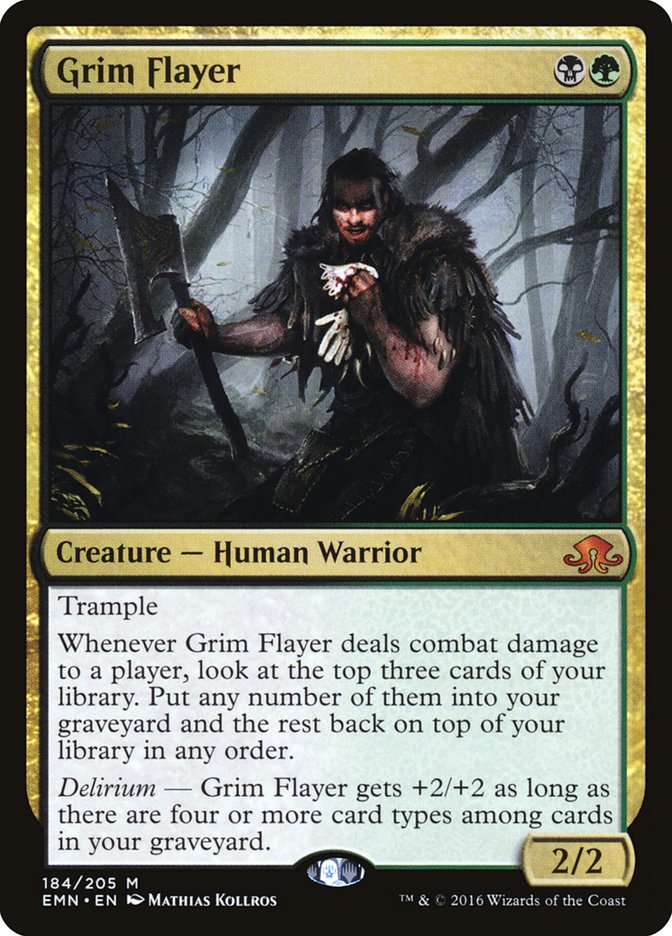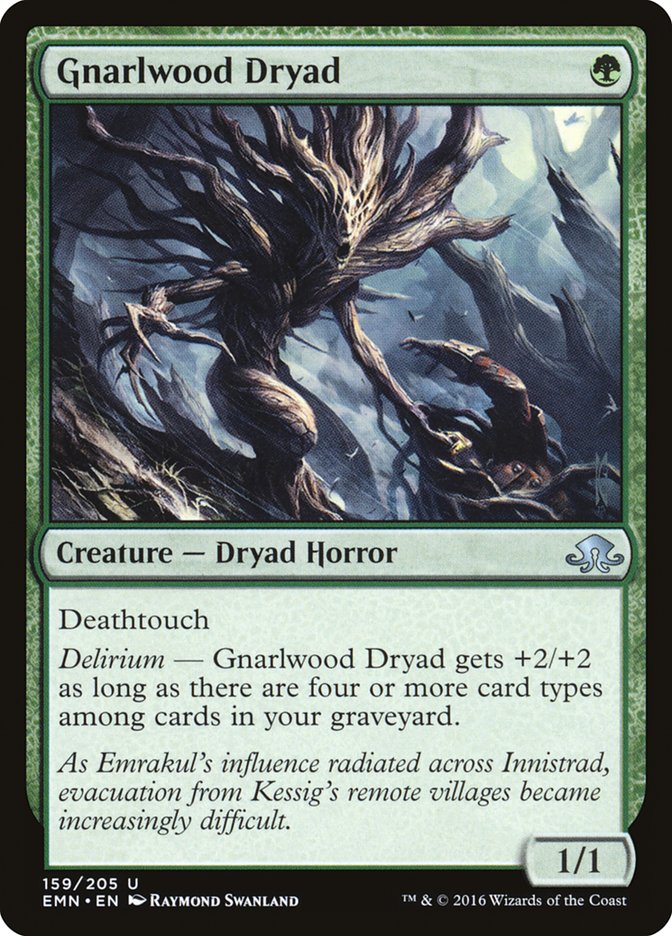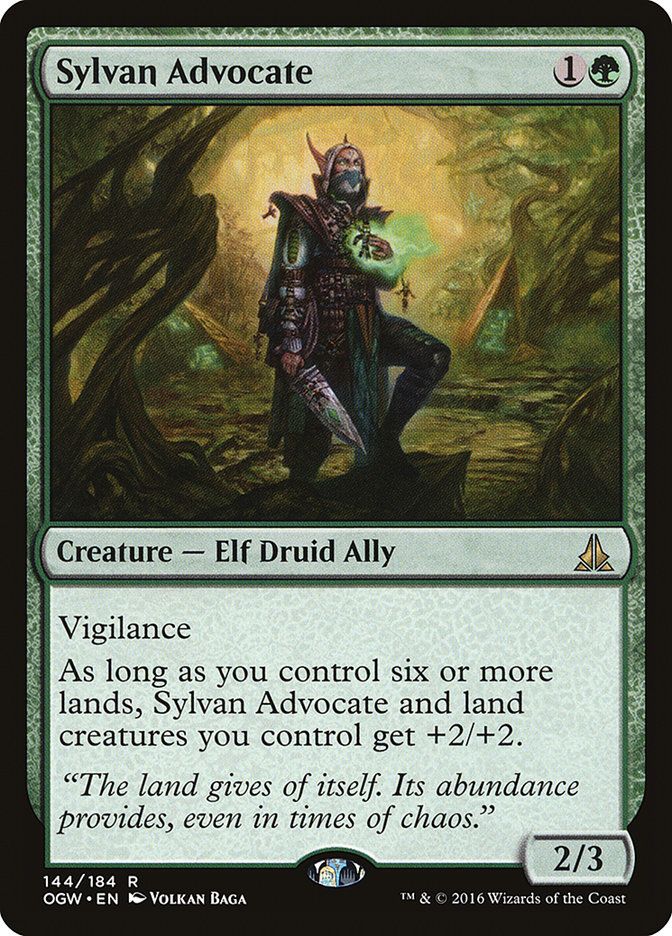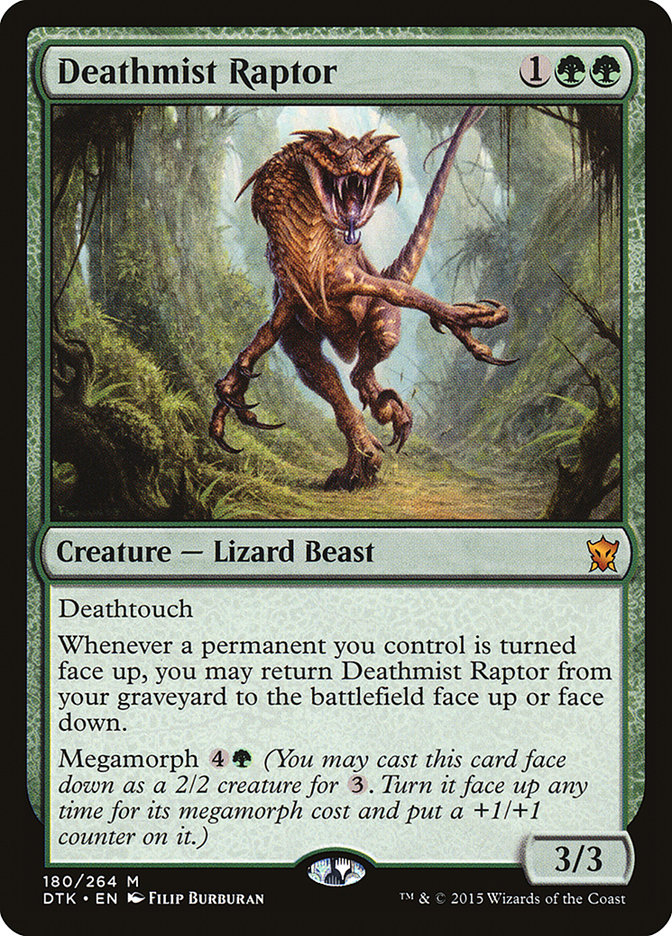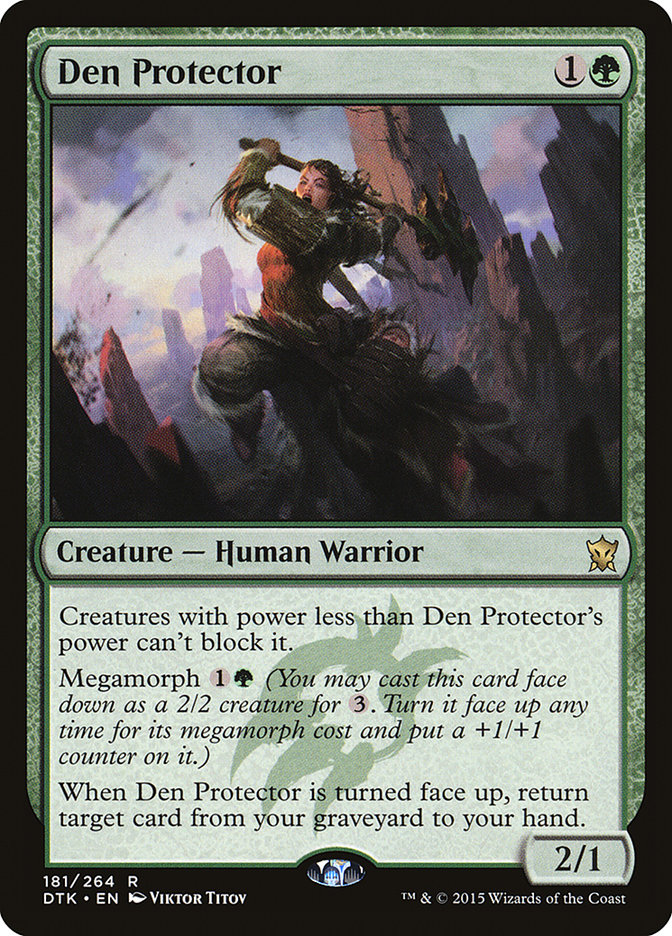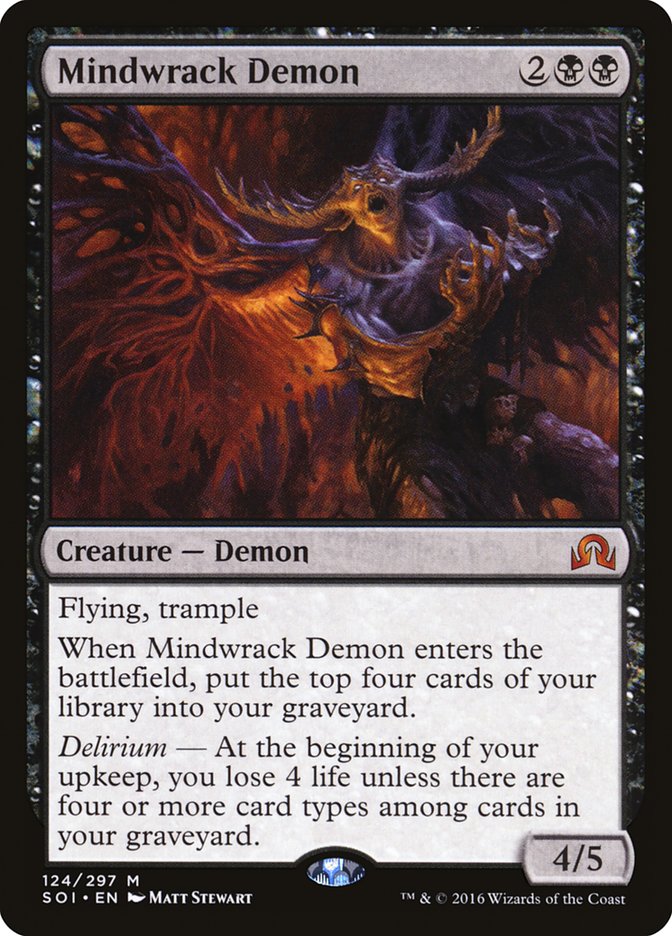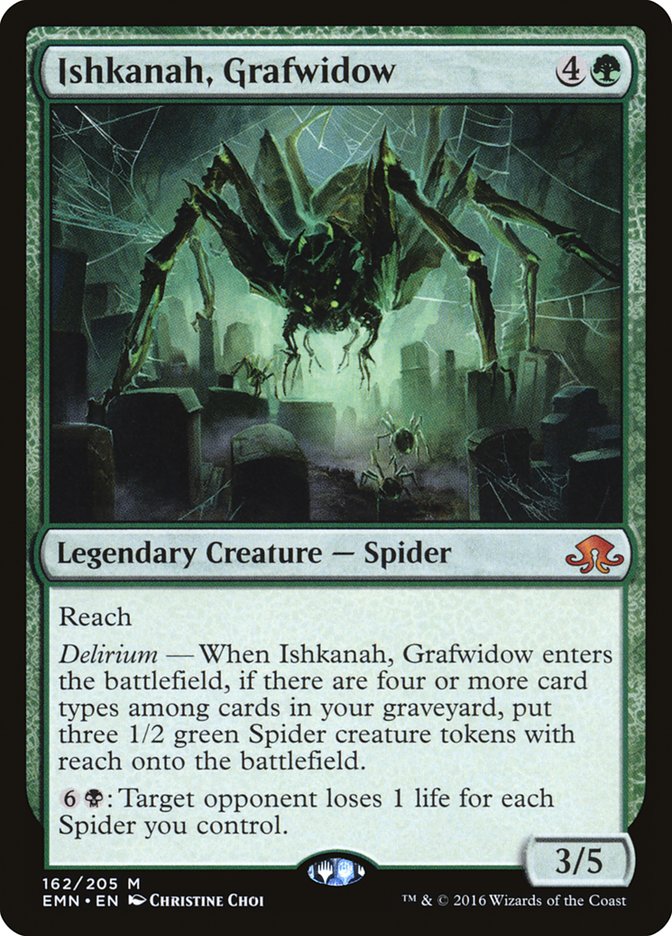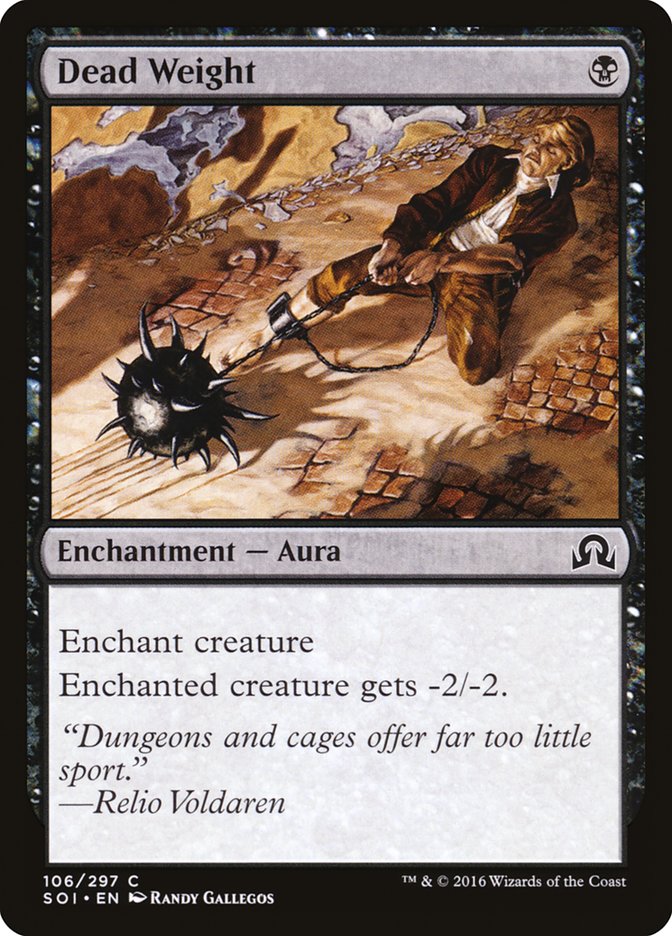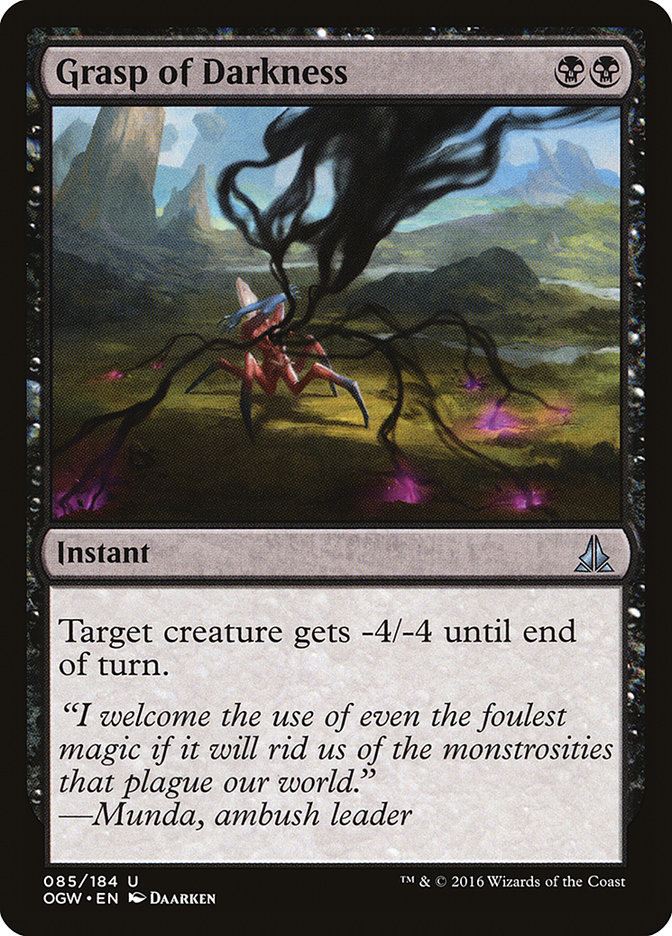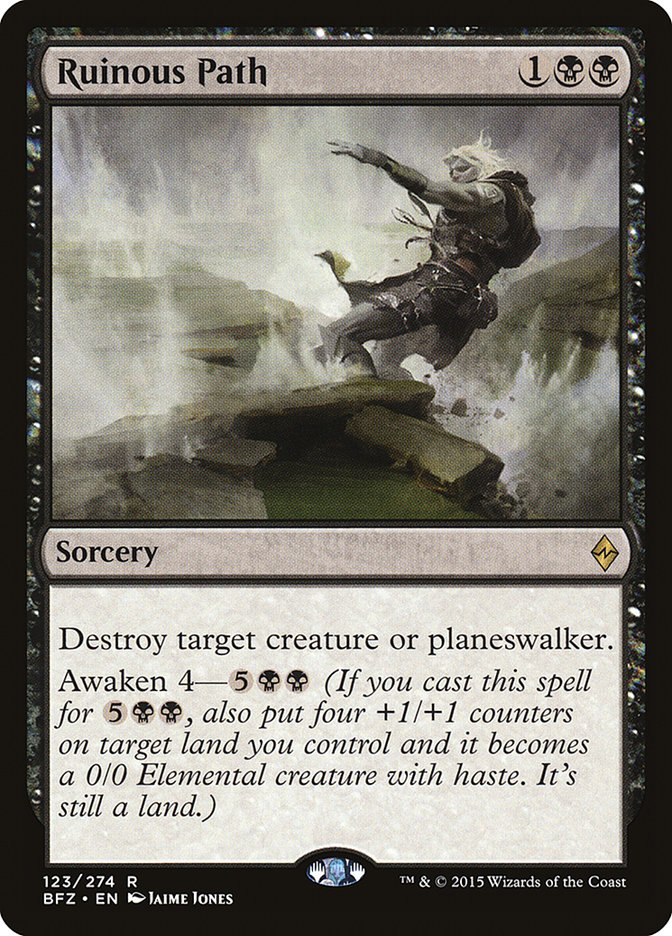Are you tired of Reflector Mage? Does Spell Queller have you down? Has Collected Company left you feeling delirious? Well, I may have the deck for you!
This past weekend at #SCGCOL I played G/B Delirium to an 11-4 finish, good for twentieth place. Before I get into the deck, I wanted to give a shout out to Robert Wright, who did some testing with the deck before the event and worked with me to complete the decklist.
Creatures (20)
- 3 Den Protector
- 4 Deathmist Raptor
- 3 Sylvan Advocate
- 2 Mindwrack Demon
- 3 Gnarlwood Dryad
- 1 Ishkanah, Grafwidow
- 4 Grim Flayer
Planeswalkers (4)
Lands (24)
Spells (12)

While labeled as “G/B Delirium,” the deck is more of a G/B Aggro deck that happens to have cards with the delirium keyword. Achieving delirium is not the focus of the deck; instead it uses removal to allow your cheap and efficient creatures to end the game quickly. Delirium is definitely a bonus, but there are no cards in the deck, such as Vessel of Nascency, that help enable delirium but do not affect the battlefield. I wanted every card in the deck to be able to interact with the opponent, as taking turns off to fill your graveyard can be extremely costly in this fast format.
Grim Flayer is the card that I have received the most questions about, and I believe most people misunderstand the card. Theoretically, a 2/2 body should not be good in a format chock-full of 2/3 creatures, but Grim Flayer is easily the best creature and probably the best card in the deck.
Now, Grim Flayer doesn’t have the stats to get there by himself, but if the deck is built around him correctly, then he can really shine. Think of Grim Flayer as the new Delver of Secrets. If your deck is built incorrectly, then Delver is just a 1/1, and Grim Flayer is similar.
If Grim Flayer deals damage to your opponent one time, usually with the help of removal spells and Liliana, the Last Hope, then the game snowballs in your favor rapidly. Grim Flayer’s ability gives you a scry 3 that also turns on delirium a high percentage of the time. If you’re interested in playing G/B Delirium Aggro, then Grim Flayer is the card to build around.
An unsung hero of the deck, it turns out Typhoid Rats is a good card when the format is warped around Dromoka’s Command. Even though Gnarlwood Dryad wasn’t a 3/3 for me too often, it frequently traded up on mana with a two- or three-drop and protected Liliana, the Last Hope very well. Bant Company likes to play their spells on your turn, which can make attacking blindly into them very difficult, but Gnarlwood Dryad is a great card to send in. I originally had 61 cards and four Gnarlwood Dryads, but I cut one at the last minute to go to 60 cards, and I regretted it the whole tournament. I would definitely play a fourth over a Sylvan Advocate going forward.
Speaking of Sylvan Advocate, it was hit-or-miss for me throughout the tournament. The biggest problem with Sylvan Advocate in this format is that the Bant Company decks are built to beat the card by playing larger creatures, going around it, or using their only removal spell in Dromoka’s Command. All of this could be said for Grim Flayer as well, but the upside that Grim Flayer has when you deal damage to your opponent is so great that Grim Flayer is in a better position against Bant Company than Sylvan Advocate is. Grim Flayer discourages your opponents from attacking and not leaving back blockers, unlike Sylvan Advocate.
Throwing it all the way back to 2015, when Deathmist Raptors still roamed the Earth. Just like with Gnarlwood Dryad, deathtouch is an extremely important keyword in this format revolving around Dromoka’s Command as the most popular removal spell. Grim Flayer and Liliana, the Last Hope both bring out the power of Deathmist Raptor / Den Protector package in similar ways. Grim Flayer is better at finding Deathmist Raptors to put in the graveyard, while Liliana, the Last Hope has the ability to return Den Protector to your hand.
Theoretically Mindrack Demon works perfectly with Gnarlwood Dryad, Grim Flayer, and Deathmist Raptor in an aggressive shell. However, in a format filled with Reflector Mage and Spell Queller, the Demon isn’t reliable. This was the card I sideboarded out the most throughout the tournament.
Good card when delirium is active and you have five mana, each of which is not a given in this deck. Never cast it during Game 1 but was happy I had it. I wouldn’t load up on too many of the legendary Spiders.
I was extremely happy with the four copies of Dead Weight in the maindeck and wouldn’t change that number moving forward. It’s the perfect card to pair with Grim Flayer and allows me to start casting multiple meaningful spells in a single turn early in the game. My guess for the most-overlooked card when others were building decks with Grim Flayer.
Grasp of Darkness was the card that overperformed my expectations the most in the tournament. Instant-speed removal is just so important, and Grasp of Darkness kills basically every threat in Standard at the moment for the low cost of two mana. I wish I could play more than four. Also pairs wonderfully when Grim Flayer is attacking because the Human Warrior has trample.
Not much to say here, just an average removal spell. Wasn’t bad, was never fantastic. Destroying a planeswalker is sometimes necessary, and Ruinous Path is the best option.
Liliana, the Last Hope is the real deal. She is one of the best three-mana planeswalkers ever printed, and that’s saying something. Liliana and Grim Flayer work so well together, the combination of the two cards really makes this entire deck. I would not be surprised at all if Liliana was the breakout card at #PTEMN, and with the sheer amount of great Bant-colored cards in Standard, that would really show how good she is.
The new Liliana pairs up extremely well with Dead Weight to effortlessly take down 2/3s and synergizes perfectly with Den Protector. There were multiple times I would use Liliana to return a Den Protector to my hand and my opponent would attack and kill Liliana. I would then use Den Protector to return Liliana to my hand, and the two cards would just continue to cycle back and forth while I would hit more land drops and fill my graveyard with Deathmist Raptors. The two cards can make an engine that can grind out any deck, including Bant Company.
Sideboarding Guide
The following is a guide of how to sideboard with my version of G/B Delirium that I played this weekend. Robert Wright and I spent most of our time before and during the tournament discussing sideboarding strategies, as it was quite difficult with this deck. We were experimenting differently throughout the day, and this is what I would recommend going forward.
Bant Company
Out:
In:
It wasn’t until after losing to the eventual champion Devin Koepke in Round 3 that I realized that Transgress the Mind is actually very good in the Bant Company matchup. Between Spell Queller, Collected Company, and Archangel Avacyn, Bant Company has the ability to play most of the game on your turn, and having a Transgress the Mind that forces the Bant Company player to react to it is valuable.
Bant Company also almost always has cards in hand, and if Transgress does miss for some reason, then you are probably winning anyway. They also may have Tragic Arrogance in their deck post-sideboard, which is a great target for Transgress the Mind.
U/W Spirits
Out:
In:
The creature package gets trimmed down as more removal enters the deck. This matchup is already favorable before sideboard and gets much better afterwards. I actively wanted to play against Spirits decks during the tournament, as it’s our best matchup.
W/R Humans
Out:
In:
This matchup looks very good on paper but can be difficult if you don’t draw well early. Mindwrack Demon has great stats for the matchup and can enable delirium for our Ishkanah, Grafwidows, but the risk of not having delirium and losing four life a turn is too great. I may want to put a second Languish in the sideboard for this matchup.
G/W Tokens
Out:
In:
Dead Weight can be useful in this matchup, most likely killing a Hangarback Walker, but the full set of four is not necessary. Gnarlwood Dryad comes out because of its weakness to Hangarback Walker in the early-game. Mindwrack Demon is a good card for this matchup, but Kalitas, Traitor of Ghet is the better four-drop to have in the deck. Play around Hallowed Moonlight with your Deathmist Raptors if you can.
Sultai Control
Out:
In:
Although I never played against this matchup, this is how I would sideboard against it. Gnarlwood Dryad is the creature with the lowest floor and is very poor against Languish. Ishkanah, Grafwidow is too slow for us in this matchup.
G/R Goggles
Out:
In:
The deck that knocked me out of Top 8 contention, G/R Goggles is easily the worst matchup. Our deck is not fast enough to stop them from playing their large haymakers that usually turn the tide in their favor. You need to pray that you draw your discard and that it is good enough against them, neither of which happened for me during my match. If G/R Goggles becomes a large part of the metagame, which I do not expect to happen, then my version of G/B Delirium Aggro is not what you want to play.
Comments from Last Week
I would like to highlight a couple of comments from my last article about the top twenty Standard cards from Eldritch Moon. I wrote the article two weeks ago, and already after Week 1 some of my picks are looking a little foolish. The list is meant to be about the set’s entirety of Standard, and it will be very interesting to see what happens when Collected Company is no longer in the format. If you would like to be featured in the Comments from Last Week section, leave a question or comment in the comments section below.
I would have added Nahiri’s Wrath and Ishkanah, Grafwidow as most undervalued cards of the set in my opinion.
-Alexis Brosseau
Leaving Ishkanah, Grafwidow out of the top twenty cards is definitely looking like a mistake, as I even played the card to much success this weekend! I don’t think Nahiri’s Wrath is playable in a format that is warped around Spell Queller, though, as getting your Wrath exiled and discarding cards as well is too much of a setback for any deck.
Any thoughts on Bedlam Reveler? I’m hearing opinions on both sides of the fence on him.
-Steven Tuckett
While very hard to look at and evaluate, I do believe Bedlam Reveler is a very strong card if there is the right support for him. Take a look at Gerry Thompson’s R/B Midrange deck in this article on the Premium side if you are looking for a deck that features Bedlam Reveler and can compete with Bant Company. Playing red allows you to play Rending Volley, which may be the best sideboard card in the format.
Baltimore Awaits!
If you’re looking for a new deck with the tools to beat the other aggressive decks of the format, such as Bant Company, then try out G/B Delirium Aggro. I don’t recommend making very many changes to the deck, but if you take a look at the sideboard guides, you will notice that Mindwrack Demon is sideboarded out a lot and Transgress the Mind is brought in a lot.
I would be comfortable taking out the two Demons and adding in two Transgress the Mind in the main in this current format, which would open up two sideboard slots to fight ramp and control decks. There could be an uptick in ramp and control decks this weekend that are built to beat Bant Company, and it would be wise to prepare for that this weekend at #SCGBALT.


